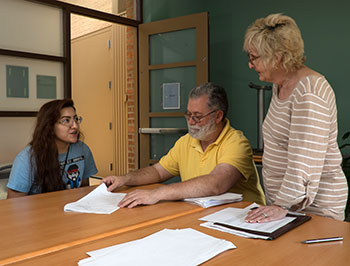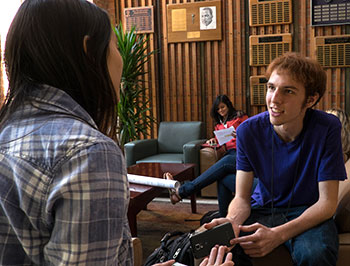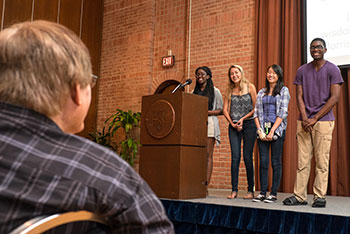A pebble dropped into a still pond sends out ripples in concentric circles whose radius increases at a constant rate of 1.5 meters per second. How rapidly is the area enclosed by the ripple increasing at the end of 10 seconds?
 , Tapia Math-Science Scholars program instructors Richard Parr, center, and Anne Papakonstantinou, right, review calculus homework with Tabitha Cerda, one of the 40 Houston-area high school students enrolled in the program. Parr and Papakonstantinou are both directors of the Rice University School Mathematics Project. Photo by Jeff Fitlow.
, Tapia Math-Science Scholars program instructors Richard Parr, center, and Anne Papakonstantinou, right, review calculus homework with Tabitha Cerda, one of the 40 Houston-area high school students enrolled in the program. Parr and Papakonstantinou are both directors of the Rice University School Mathematics Project. Photo by Jeff Fitlow.
Students who participated in the new Tapia Math-Science Scholars program at Rice last month probably know the answer: 141.3 meters squared per second. Such mathematical scenarios were the focus of 40 Houston-area high school students in the program, a unique collaboration of Rice’s Richard Tapia Center for Excellence and Equity, the Rice University School Mathematics Project (RUSMP) and the Houston Independent School District (HISD).
“In a nutshell, it was a four-week resident-at-Rice program for HISD students interested in studying the foundations of calculus and learning from some of the very best science, technology, engineering and math (STEM) professors in the U.S.,” said Juliet Stipeche ’96, associate director of the Tapia Center.
But the program was much more than equations and formulas. The students learned about the resources available at institutions like Rice, discussed social issues and developed leadership skills.
The students also met leaders in science and industry who shared their stories about how they chose a science career and about their own research and why it is important. They also discussed the role that math plays in their work. Among those speakers was Richard Tapia himself. He shared his own inspiring story: The son of Mexican immigrants, Tapia was the first member of his family to attend college. Today he is University Professor, the Maxfield-Oshman Professor in Engineering and a professor of computational and applied mathematics. Moreover, his research and dedication to diversity education in the U.S. have achieved a number of distinguished honors, including the National Medal of Science from President Barack Obama.
Organizers hope that like the pebble in the pond, the program will create a ripple effect in the students’ lives — one that will emanate far beyond the classroom walls.
“The overwhelming majority of the Tapia scholars are underrepresented minorities who are economically disadvantaged,” Stipeche said. “Professor Tapia’s goal was to open the Ivory Tower of Rice University to HISD students interested in STEM. We collaborated with the community and gave the students a learning experience that we hope will impact them for the rest of their lives. These students will forever be a part of Professor Tapia’s pursuit of excellence and equity in education.”
The demographics of the Tapia scholars — juniors and seniors who had to apply to attend the program — mirrored the composition of HISD. During the program, they lived on campus Monday through Friday and had a full schedule: In the mornings they learned the foundations of calculus — from mathematical models for analyzing water usage and computing the square root of the number 2 to depicting obesity rates in the United States and evaluating the evidence for global warming. Among their instructors were RUSMP directors Anne Papakonstantinou ’69 — “Dr. Papa” to her students — and Richard Parr ’85.
“Richard and I truly enjoyed every aspect of working with these 40 remarkable students, from helping with their individual questions to better understand the material we presented to leading a math tour of the campus for them,” Papakonstantinou said. “Their strong work ethic and interest in mathematics ensured that they achieved all the goals that we set forth for them.”
The students agreed the program was rigorous and challenging, but rewarding as well, thanks to the instructors and tutors — nine Rice undergraduates, all STEM majors, and three STEM graduates from the University of Houston’s TeachHouston program. They were on hand to assist the students with their daily homework assignments and with their applied math research projects, which the students presented at a research symposium Aug. 1.

Adam Morrison, a Rice rising sophomore majoring in computer science and philosophy, was one of the nine tutors who worked with the students of the Tapia Math-Science Scholars program. Photo by Jeff Fitlow.
Rebecca Ndebee of Sharpstown International School said that coming into the program, students thought they had to know everything. “Literally, when we all came here, we all knew something in some areas, but overall, generally, we didn’t know everything.” She said students eventually realized that they will “get there.” “Everyone will get there together,” Ndebee said.
“Dr. Papa and Mr. Parr were really a great help,” said Irasema Cruz of Energized for STEM Academy. “It’s a learning process.”
Melanie Salazar of Austin High School said the material was presented in a way that let the students apply the concepts they were learning. She particularly liked working on the research projects. “You get to interact with a team, and the topics really make you think.”
“We set very high standards, and the students met and exceeded our expectations, Stipeche said. “Three students demonstrated a 1,000 percent increase in their (pre- and post-program testing) scores. The results demonstrate the hard work, dedication and effort that the students invested in their learning.”
In the afternoons the students had “enhancement lectures” by Rice professors and other academic and business leaders to give context to the mathematic foundations they were learning — lectures on such topics as using math to improve the treatment of cancer, data-mining techniques and how statistics guide researchers to answers. They also delved into social issues — concepts of leadership, underrepresentation of minorities in math and sciences, social justice and discrimination.
“We talked about the environment, social justice, environmental justice and we watched movies about discrimination,” said Amber Liu of Bellaire High School. “Having discourse about it and having more awareness, it helps to take one step at a time to combating racism.”
It wasn’t all work, though. Every evening there was recreation, often a movie, and lights out at 10:30.
“From the beginning of the first day, they always taught us to keep everything balanced,” said Eligio Cisneros of Austin High School. “Just as you must make time for studying, you must make time for yourself.”
During the last week of the program, the students reflected on the experience.
“I’ve learned a lot about being college-ready,” said Ndebee, who is now looking into colleges she’s interested in attending and what she has to do to meet their requirements. “I did that with my tutor, and to be honest, I don’t think I would have done that on my own. I wouldn’t have known where to begin.”
Mireya Ortiz of Austin High School said, “Aside from all the math, it’s a lot of responsibility being here too. Actually being here, staying here — it’s giving us incentive to go to college.”
That’s exactly the hope of the program’s namesake.
“Because of Rice’s reputation and resources, we can demonstrate, project and enhance the pursuit for excellence in a most credible manner,” Tapia said. “They experienced excellence and now will pursue it and not be satisfied with less.”



Leave a Reply